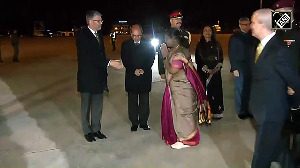Amid reports that a new reactor being built by Pakistan could make fuel for up to 50 nuclear warheads a year, US officials have said the facility under construction is much smaller than claimed and could simply be a replacement for the existing one in Khushab.
'We have consulted with our experts and believe the analysis (by Institute for Science and International Security) is wrong,' Frederick Jones, a spokesman for the National Security Council, told the New York Times.
'The reactor is expected to be substantially smaller and less capable than reported,' he said.
The US media last week carried the report by the Washington-based institute, which is a private arms control group, amid debate over the Bush administration's nuclear deal with India and raised fears that Pakistan was trying to speed ahead in a South Asian arms race.
The group's experts had on Wednesday said they stood by their report, which is based mainly on the examination of commercial satellite images of the half-built reactor.
But, federal officials said their own intelligence indicated that the emerging reactor appeared to be roughly the same size as the small one Pakistan currently uses to make plutonium for its nuclear programme, and said the new model might be intended to replace the old one, the Times reported.
The old reactor in Khushab makes two nuclear warheads a year.
'This has been looked at for a long time and has not generated a lot of hand-wringing," a senior
Both old and new reactors were said to require heavy water, a costly substance. But federal officials, including some specialising in nuclear intelligence, said they had seen no evidence in Pakistan of an ability to make the far larger amounts of heavy water that a big new plutonium reactor would require, the Times said.
David Albright, President of the institute, defended the accuracy of his group's report and noted the Bush administration's poor record on nuclear intelligence.
'We are confident in our evidence and calculations,' he told the paper, adding that if the administration wanted to produce the reasons it thinks we are wrong, we will be happy to examine them with an open mind.
Albright said that the circular reactor vessel of the new Pakistani reactor was clearly visible in satellite photos and that its diameter -- about 16 feet -- was similar to those of heavy-water reactors at the Savannah River plant in Aiken.
But Thomas B Cochran, director of the nuclear programme at the Natural Resources Defense Council in Washington, a private group that has long monitored atomic developments around the world, said Albright's group had apparently misinterpreted the purpose of the circular object.
Rather than a reactor vessel, he said, it probably represented thick rings of metal and concrete shielding meant to block high heat and dangerous radiation from a reactor that will prove to be much smaller, the paper reported.






 © 2025
© 2025